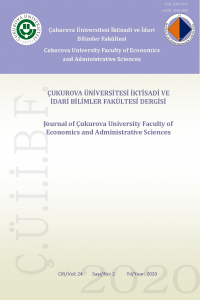Türkiye’de Araştırma Geliştirme Harcamaları ile Doğrudan Yabancı Yatırım İlişkisi: Sınır Testi Yaklaşımı
Bu çalışmada, araştırma geliştirme (Ar-Ge) harcamalarının doğrudan yabancı yatırım (DYY) girişi üzerindeki etkisi, 1990-2013 dönemine ait veriler kullanılarak, sınır testi yaklaşımıyla araştırılmıştır. Sonuç olarak, uzun dönemde ARGE harcamaları ile doğrudan yabancı yatırım girişi arasında anlamlı bir ilişki bulunmuştur. Kısa dönem analizinde ise AR-GE harcamalarının doğrudan yabancı yatırım girişini cari dönemde artırmasına rağmen bir dönem sonra azalttığı bulgusu tespit edilmiştir.
Anahtar Kelimeler:
Araştırma- Geliştirme Harcamaları, Doğrudan Yabancı Yatırım, Sınır Testi
Research and Development and Foreign Direct Investment Relationship in Turkey: A Bound Testing Approach
In this study, the impact of reserach and development (R&D) expenditures on foreign direct investmnet (FDI) entry were investigated using data for period 1990-2013 by bounds testing approach. As a result, long term between R&D expenditures and foreign direct investment inflows have been found a significant relationship. In the short term analysis, R&D expenditures decrease foreign direct investment inflows after a period despite R&D expenditures increase foreign direct investment inflows during current period.
___
- Almfraji, Mohammed Amin, Almsafir, Mahmoud Khalid, Yao, Liu (2014), “Economic Growth and Foreign Direct Investment Inflows: The Case of Qatar”, Procedia- Social and Behavioral Sciences, 109, 1040-1045.
- Anwar, Sajid, Nguyen, Lan Phi (2013), “Is Foreign Direct Investment Productive? A Case Study of the Regions of Vietnam”, Journal of Business Research, 1-12.
- Asheghian, P. (2004), “Determinants of Economic Growth in the United States The Role of Foreign Direct Investment”, The International Trade Journal, 18:1, 63- 83.
- Blomstrom, M., Lipsey, R., Zejan, M. (1994), “What explain developing country growth? In: Baumol, Convergence and Productuvity: Cross- National Studies and Historical Evidence”, Oxford University Press, Oxford.
- Borensztein, E., Gregorio, J. De, Lee, J-W. (1998), “How Does Foreign Direct Investment Affect Economic Growth?”, Journal of International Economics, 45, 115-135.
- Chang, Tsangyao, Wenshwo Fang and Li-Fang Wen (2001), “Energy Consumption, Employment, Output and Temporal Causality: Evidence From Taiwan Based on Cointegration and Error-Correction Modelling Techniques”, Applied Economics, Sayı 33, 1045-1056.
- Demir, Osman, Üzümcü, Adem, Duran, Serap (2006), “İçsel Büyümede İçselleştirme Süreçleri: Türkiye Örneği”, Dokuz Eylül Üniversitesi İktisadi ve İdari Bilimler Fakültesi Dergisi, Cilt:21, Sayı:1, 27-46.
- Dickey, David A., Fuller, Wayne A. (1979), “Distribution of the Estimators for Autoregressive Time Series with a Unit Root”, Journal of American Statistical Association, Sayı 74, 427-431.
- Findlay, R., (1978), “Relative Backwardness, Direct Foreign Investment, and the Transfer of Technology: A Simple Dynamic Model”, Quarterly Journal of Economics, 92, 1-16.
- Fosu, Oteng-Abayie Eric, Magnus, Frimpong Joseph (2006), “Bounds Testing Approach to Cointegration: An Examination of Foreign Direct Investment Trade and Growth Relationships”, American Journal of Applied Sciences, Sayı 3, Cilt 11, 2079-2085.
- Göker, Aykut (2004), Teknoloji, Türk Mühendis ve Mimar Odaları Birliği 50. Yıl Yayınları, Ankara.
- Kathuria, V., Das, S. (2005), “Impact of FDI on R&D Strategies of Firms in the Post 1991 Era”, Management Review, 17(2), 17-28.
- Korkmaz, Suna (2010), “Türkiye’de AR-GE Yatırımları ve Ekonomik Büyüme Arasındaki İlişkinin VAR Modeli ile Analizi”, Journal of Yasar University, 20(5), 3320-3330.
- Kornecki, L., Raghavan, S. (2008), “FDI and Economic Growth: An Empirical Analysis of Central and Eastern European Countries”, European Journal of Management, 8,4.
- Nelson, Charles R., Plosser, Charles I. (1982), “Trends and Random Walks in Macro- economic Time Series: Some Evidence and Implications”, Journal of Monetary Economics, Sayı 10, 139-162.
- Perron, Phillips (1989), “The Great Crash, The Oil Price Shock and the Unit Root Hypothesis”, Econometrica, Sayı 57, 1361-1401.
- Pesaran, Hasheem M., Shin, Yongcheol, Smith, Richard J. (1996), “Testing for the Existence of a Long Run Relationship”, DAE Working Paper, No. 9622, University of Cambridge.
- Pesaran, Hasheem M., Shin, Yongcheol (1999), “An Autoregressive Distributed Lag Modelling Approach to Cointegration Analysis”, Edt: S. Strom, Econometrics and Economic Theory in 20th Century: The Ragnar Frisch Centennial Symposium,Chapter 11, 371.413. Cambridge: Cambridge University Press.
- Pesaran, Hasheem M., Shin, Yongcheol, Smith, Richard, J. (2001), “Bounds Testing Approaches to the Analysis of Level Relationsips”, Journal of Applied Econometrics, Sayı 16, Cilt 3, 289-326.
- Pesaran, Baharram, Pesaran, M. Hashem (2009), “Time Series Econometrics Using Microfit 5.0”, New York: Oxford University Press Inc.
- Salehizadeh, M. (2005), “Foreign Direct Investment Inflows and the US Economy: An Empirical Analysis”, Economic Issues, 10:2, 29-50.
- Sasidharan, Subash, Kathuria, Vinish (2011), “Foreign Direct Investment and R&D: Substitutes or Complements- A Case of Indian Manufacturing after 1991 Reforms”, World Development, Vol.39, No.7, 1226-1239.
- Sinanoğlu, Oktay (2013), Adam, Bilim+Gönül Yayınları, İstanbul.
- Tintin, Cem (2013), “The Determinants of Foreign Direct Investment Inflows in the Central and Eastern European Countries: The Importance of Institutions”, Communist and Post-Communist Studies, 46, 287-298.
- Zhang, Kevin Honglin (2013), “How Does Foreign Direct Investment Affect Industrial Competitiveness? Evidence From China”, China Economic Review, 1-10.
- Ziylan, Aytekin (2001), “Ar-Ge’ye Dayalı Tedarik, Evrimsel Tedarik, Milli Ana Yüklenicilik”, Proje Yönetim Derneği Kongresi, İstanbul.
- ISSN: 1300-3747
- Başlangıç: 1987
- Yayıncı: Çukurova Üniversitesi
Sayıdaki Diğer Makaleler
Kurumsal Kalite ve Ekonomik Büyüme: Panel Nedensellik Analizi
Cengiz AYTUN, Cemil Serhat AKIN
Üniversite Öğrencilerinin Bireysel Değerleri ve Girişimcilik Eğilimleri
Erdinç BALLI, Ayşe İpek Koca BALLI
Burhan AYDEMİR, Uğur SAYLAN, Fatih AYDOĞMUŞ
Uzaktan Eğitim ve Uzaktan Eğitim Platformları’nın Karşılaştırılması
Deniz HERAND, Zeynep Azize HATİPOĞLU
